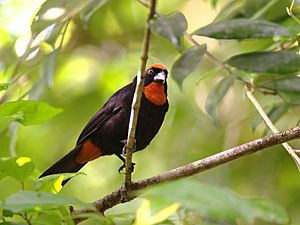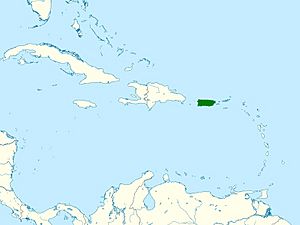Puerto Rican bullfinch facts for kids
Quick facts for kids Puerto Rican bullfinch |
|
|---|---|
 |
|
| Conservation status | |
| Scientific classification | |
| Genus: |
Melopyrrha
|
| Species: |
portoricensis
|
 |
|
| Synonyms | |
Loxigilla portoricensis |
|
The Puerto Rican bullfinch (Melopyrrha portoricensis) is a small bird found only in the archipelago of Puerto Rico. It is a type of bullfinch and tanager. You can often find this bird in thick forests across Puerto Rico, though it is not usually seen on the island's far eastern side. This bullfinch eats seeds, fruits, insects, and spiders. Its nest is shaped like a ball with an opening on the side. Usually, a female bullfinch lays three light green eggs.
Contents
What Does the Puerto Rican Bullfinch Look Like?
The Puerto Rican bullfinch has black feathers. It also has bright orange patches above its eyes, around its throat, and under its tail. This bird is about 17 to 19 centimeters (about 7 inches) long. It weighs around 32 grams, which is about the same as a few quarters.
Where Do Puerto Rican Bullfinches Live?
These bullfinches are most common in dense mountain forests. However, they can also live in other places. You might find them in lower forests with thick plants, coffee farms, or bushy areas. They can even live in dry coastal thickets. Sometimes, but rarely, they are found in mangrove swamps.
Even though they are found all over the island, their numbers might be getting smaller. Their living areas may also be shrinking.
What Do Puerto Rican Bullfinches Eat?
Puerto Rican bullfinches mostly eat fruit. They seem to prefer fruit when it is available. But they also eat other plant parts and small animals. This includes insects and spiders.
Scientists do not know exactly what young bullfinches eat. However, most fruit-eating birds feed their babies a lot of animal matter. This is especially true when the babies are very young. As they grow, the chicks likely start eating fruit and insects too. Because these birds can change what they eat and how they find food, they are considered a "generalist" species. This means they are good at adapting to different food sources.
Life Cycle and Reproduction
The main time for Puerto Rican bullfinches to breed is thought to be from March to June. This happens in the wet and moist forests of Puerto Rico. In these wet forests, the seasons do not change much. So, bullfinches might nest at different times throughout the year.
In the dry forests of southwestern Puerto Rico, most birds breed during the rainy season. This is usually from late April to July. During the dry season (December to April), there might not be enough food. This makes it hard for birds to raise their young successfully. Scientists think bullfinches in dry forests might also breed when they have the chance. They might try to breed again during a shorter rainy period in September and October.
Nests and Eggs
The Puerto Rican bullfinch usually builds its nest close to the ground. They build them in trees or shrubs. All birds in the Melopyrrha group, which are only found in the Caribbean, build dome-shaped or ball-shaped nests. They lay 2 to 3 dull greenish eggs with dark spots.
The bird builds its nest using woven plant materials and sticks. The inside of the nest is often lined with pieces of bark. The nest has an opening on the side. It can be placed in a tree fork, on a branch, or inside a tree hole. Sometimes, they build nests in shrubs or clumps of grass.
Observations suggest that the female bird sits on the eggs for about 14 days. When the chicks hatch, they are naked for 3 to 4 days. After that, their flight feathers start to grow. They are ready to leave the nest about 14 to 15 days after hatching.
Protecting the Young
Many nests fail because predators eat the eggs or young birds. In the Guanica region, the pearly-eyed thrasher (Margarops fuscatus) is a common predator. Other animals that might eat eggs or chicks include:
- Red-legged thrushes (Turdus plumbeus)
- Puerto Rican racers (Borikenophis portoricensis)
- Anoles (Anolis spp.)
- Small Indian mongooses (Urva auropunctata)
- Green iguanas (Iguana iguana)
- Feral cats (Felis catus)
- Black rats (Rattus rattus)
Nests are more likely to be successful when there is more fruit available. They also do better with more rain and when the nest is lower to the ground.
See also
 In Spanish: Semillero puertorriqueño para niños
In Spanish: Semillero puertorriqueño para niños


